|
Please observe all trail closures and barriers. Trails are closed for a variety of reasons, such as for visitor safety, to protect endangered species, to prevent erosion, and/or to allow new sections of trail to harden. Visitors who disregard trail closures may endanger themselves and any potential rescuers, harm threatened and endangered species, exacerbate erosion, or prevent new sections of trail from properly hardening, which results in the degradation of the trail surface, which in turn may require the closing of the trail for repair. Thank you for your cooperation. Caution: Many trails in the Woodward Fire zone (e.g., south of Limantour Road and west and north of Bear Valley Trail) are lined with hazard trees that were partially burned in the fire. These trails may also be subject to flash flooding, debris flows, and loose falling rocks during rain storms. Caution: Many trails in the park are overgrown with grass and annuals. The park's trail crew is working to address the trail conditions as quickly as possible, but please anticipate wading through vegetation as you hike, and check yourself for ticks during and after your hike. Visit our Hiking at Point Reyes National Seashore and Trail Guide & Suggested Hikes pages for additional information. Table of ContentsTrails Blocked by Downed Trees

Trails Blocked by Downed TreesStorms throughout the year can blow down trees throughout the wooded sections of Point Reyes National Seashore. Please avoid the trails listed below until the downed trees have been cleared. Or, if you do use these trails, don't create new paths to get around any downed trees you encounter; do your best to follow the route of the official trail over, through, or under the downed tree, if it is safe to do so. Walking around downed trees results in the trampling of vegetation and the creation of undesired paths, which can result in increased erosion. Leave No Trace. Thank you for your cooperation in helping better preserve the wildness of your national seashore. Updated: Thursday, April 18, 2024
If you encounter any downed trees within Point Reyes National Seashore or the northern district of Golden Gate National Recreation Area, please report them to the Bear Valley Visitor Center (415-464-5100 x2 x5) or to Shawn Maloney (415-464-5154) or by email. If you encounter any downed trees along the Rift Zone Trail south of the Vedanta Society Retreat access road and north of the Stewart Ranch, please contact Marin County Parks (click on the "Email Parks" button). Please provide as many details as possible, i.e., exact location of the tree on which trail, type of tree (bay, fir, etc.), whether it is bushy or straight, its size and diameter, whether it is on the ground or elevated, whether equestrians can get around it, etc. If you have recently hiked any of the trails in Point Reyes National Seashore and found the trail conditions other than what is reported here, please email us to let us know. Thanks for your assistance. Hiking at Point Reyes National Seashore Flooded TrailsWinter storms can result in the flooding of a number of park trails. Please avoid the following trails during the week or so after significant rain storms. Or, if you do use these trails, plan on getting your feet wet. Leave No Trace principles instruct hikers to walk single file in the middle of the trail, even if it is under several inches of water or very muddy. Do not attempt to walk around flooded or muddy areas as doing so results in the trampling of vegetation and the undesired broadening of the width of the trail, which can result in increased erosion. Thank you for your cooperation in helping better preserve the wildness of your national seashore. The following trails frequently flood during wet winters and springs:
Bolema Trail severely ruttedDuring the January 2023 storms, severe rutting occurred on the Bolema Trail, which may make the trail too hazardous for equestrians to safely use. Please avoid riding horses on the Bolema Trail until further notice. Laguna Trail seasonal floodingThe Laguna Trail currently passes through a number of vernal pools, which consistently fill in the winter and early spring and dry out in the late spring-early summer. The park cannot drain them as they are protected and provide important habitat for a variety of species. The park hopes to ultimately reroute this section of the Laguna Trail to avoid these vernal pools. Olema Valley Trail seasonal floodingDuring the winter and spring, the Olema Valley Trail is often flooded and very muddy in a number of locations and hikers on this trail in the winter and spring may wish to wear or bring along knee-high waterproof boots. There is a ford just south of the Teixeira trail junction at which the water is frequently knee-deep and opaque with silt, the current strong, and the bottom uneven and covered with unstable, loose stones. This section of Olema Valley Trail is subject to seasonal (winter/spring) flooding. Hiking at Point Reyes National Seashore Hazardous ConditionsCattleIf you plan to hike or ride a trail that leads through cattle pasture, please read Understanding Working Rangelands: Sharing Open Space: What to Expect from Grazing Livestock (1,314 KB PDF). By understanding basic cattle behavior, you can give yourself a better chance to predict how cattle are likely to react to your presence and in response to your actions. This will help make your hike or ride through these areas safer and more enjoyable. Trails in Point Reyes National Seashore that pass through cattle pasture:
Trails in the northern district of Golden Gate National Recreation Area that pass through cattle pasture:
Hiking at Point Reyes National Seashore Coastal Erosion of Trails to BeachesPlease be aware that coastal zones are dynamic areas and can change from one day to the next. Erosion by waves, rockfalls, or landslides occur frequently. As a result, the condition of lower trail sections leading to beaches are likely to change throughout the season. This may result in abrupt drops on loose, steep gravel to get to and from the beach. Although any beach in the park can be affected, McClures Beach and Palomarin Beach are known to have these hazards. Use caution, remember that you'll have to come back up anything that you descend. Kelham Beach TrailOn Saturday, January 14, 2023, a visitor reported that erosion had eliminated the lowest 12 feet or so of steps at the bottom of the Kelham Beach Trail. On Sunday, April 14, 2024, a much larger landslide occurred, taking out even more of the Kelham Beach Trail. Please do not use the Kelham Beach Trail until repairs have been made. If you descend onto the beach, you may not be able to get back up. Sculptured Beach TrailErosion from the January 2023 storms eliminated the lower section of steps at the bottom of the Sculptured Beach Trail. The park has decommissioned the Sculptured Beach Trail. Please do not attempt to follow the route of the decommissioned Sculptured Beach Trail. Doing so will impede the revegetation of the former trail. Palomarin Beach Trail closedPlease note: On September 24, 2020, the decent to Palomarin Beach was determined to be unsafe due to unstable and failing sections of the trail. The Palomarin Beach Trail (e.g., the 0.6-mile-long trail from the Coast Trail to Palomarin Beach) is closed to all visitors, employees, and local residents until further notice. (27 KB PDF) This closure has no direct impact to hikers using the Coast Trail leading north from the Palomarin Trailhead. 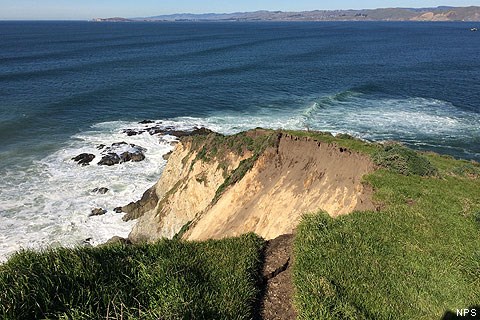
Collapse of Bluff near Tomales PointIn January 2017, part of the bluff at the northern end of Tomales Point collapsed. As a result, a section of the Tomales Point Trail is no more. As of February 2024, large cracks are present in the ground, some several feet from the edge. If you plan on hiking to Tomales Point, be aware that additional sections of the cliff are likely to collapse. If you are hiking anywhere that brings you near cliffs, please be mindful of the hazards. Be aware of your surroundings and stay back from the edge. Many of the cliffs around Point Reyes are unstable and prone to collapse. Thank you to the visitor that reported this new collapse. Similar to the fissure that formed on top of Arch Rock, visitors discovered these hazards before park staff did. You can help park staff better protect park visitors by contacting the park's Dispatch at 415-464-5170, or by sending us an email if you find anything that looks hazardous in the park. Hiking at Point Reyes National Seashore 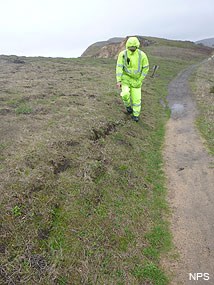
Fissures Near the Chimney Rock TrailCracks were reported on a portion of the bluff near the Chimney Rock Trail on December 21, 2015. These fissures could indicate the possibility of a weakening cliff face in the area. The land may be unstable and a collapse or erosion could occur. Visitors are reminded to stay on designated trails. Bluffs along the California coast are inherently unstable. They are prone to crumbling and sliding, especially in wet weather. It is very dangerous to climb or walk along the edge of cliffs. Be aware of falling rocks if walking near the base of a rock face. View: Temporary Trail ClosuresPlease observe these trail closures. Visitors who disregard trail closures risk their own safety (and those of rescuers) and/or may prevent new sections of trail from properly hardening, which results in the degradation of the trail surface, which in turn may require the closing of the trail for further repair. Thank you for your cooperation.
Hiking at Point Reyes National Seashore Indefinite or Permanent Trail ClosuresArch Rock Trail: Alamere Falls "Trail": Crystal Lake Trail: Double Point Trail: Drakes Beach Trail: Palomarin Beach Trail: Sculptured Beach Trail: West Pasture North Levee: Hiking at Point Reyes National Seashore 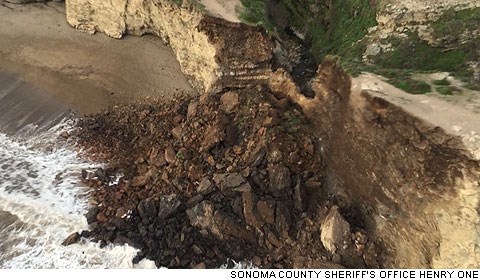
Trail Leading to Arch Rock is ClosedA portion of the Arch Rock overlook collapsed on Saturday, March 21, 2015, killing one person and injuring another. The Arch Rock Spur Trail and the area leading up to Arch Rock (e.g., the area southwest and west of the junction of the Coast Trail and the Arch Rock Spur Trail) is closed for your safety. The land may still be unstable and further collapse or erosion could occur. The Bear Valley Trail and the Coast Trail in this area remain open. For your own safety, and to prevent the trampling of vegetation, please remain on park-maintained trails. Bluffs along the California coast are inherently unstable. They are prone to crumbling and sliding. It is very dangerous to sit, rest, climb, or walk along the edge of cliffs. Be aware of falling rocks if sitting or walking near the base of a rock face. more... 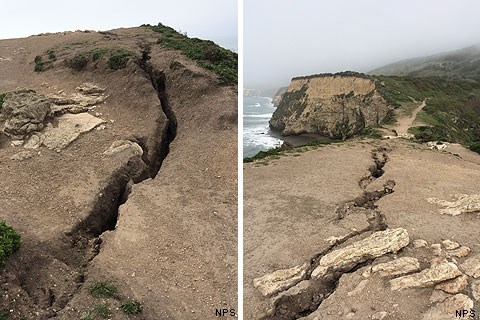
Background on the collapse of Arch RockOn Thursday, March 19, 2015, an off-duty employee hiking on his day off discovered what he suspected was a new hazardous condition at Arch Rock and reported the hazard to park management. Visible fissures had formed along the top of Arch Rock, indicating that the rock structure underneath had weakened, and, on March 21, 2015, Arch Rock collapsed. After Arch Rock collapsed, many visitors reported that they had seen the fissure during the March 14, 2015, weekend. But, before March 19, park staff were unaware of this new hazard. You can help park staff better protect park visitors by contacting park dispatch at 415-464-5170 or by sending us an email if you find anything that looks hazardous in the park. Completed significant trailworkWoodpecker Trail: Woodpecker Trail: Bear Valley Trail: 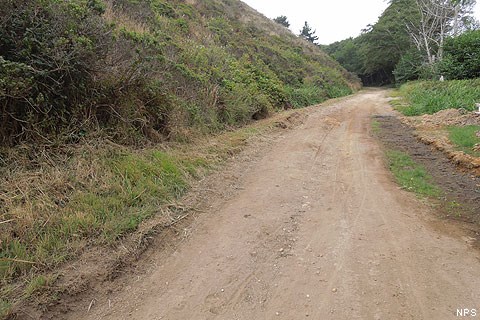
Coast Trail Reopened 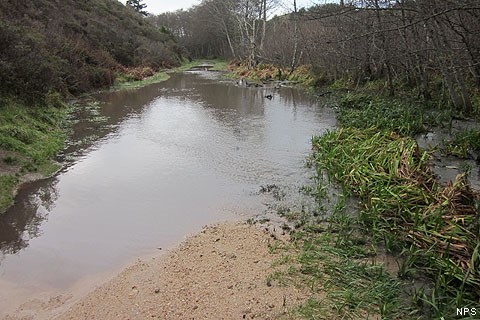
The trail had become impassable due to water and mud and presented an unsafe condition for park visitors and was therefore closed on June 1, 2012. Even though the trail is once again open, NPS staff will continue to proceed to acquire all necessary permits for short-term repairs to the trail and also for a permanent fix. This section of Coast Trail is subject to seasonal (winter/spring) flooding. Muddy Hollow Trail: Greenpicker Trail: Kelham Beach Trail: Giacomini Wetlands Trails: Estero Trail - Muddy Hollow Dam Removal: Hiking at Point Reyes National Seashore |
Last updated: April 18, 2024
